





This is one of a series of articles on some of the most interesting and easiest succulents to grow. The Climbing Onion is familar already to many succulent enthusiasts, but it is becoming more and more popular with gardeners and growers of all ages and skill levels. The following article serves as an introduction to this peculiar plant and has some ideas on how to take care of one.
I am not a fan of plants that croak soon after I get them home, yet that happens over and over again. This happens particularly often when I espy some weird rock-like succulent and decide to try once more to keep such a weird thing alive for at least a few weeks. Some plants just say ‘rot' all over them, and sure enough, once in my hands, that's exactly what happens. Bowiea volubilis is just one of those plants that looks, to me, like it will rot with even a drop of extra water at the wrong time. Yet, after reluctantly getting one that my wife insisted upon (she fell in love with the weird ball-shaped peeling onion as soon as she saw one at a cactus/succulent sale) I was amazed (and relieved) to discover that, despite my best efforts to do otherwise, this was a tough plant to kill. So tough, in fact, that I now have 6 of them and have long since relaxed with all of them (save my wife's ‘pet'), watering them whenever I feel like it and being quite careless about protecting them from excessive sun, shade, cold, rain, heat etc. All are still doing great and seem hardly the worse for wear.
Bowiea volubilis, aka the Climbing Onion, is an ‘above-ground' bulb in the Hyacinth family that is particularly well adapted to an arid climate, but one which sees heavy rainfall and even flooding at times. It is also called the Sea Onion, but I am less clear on the origin of this name as it most certainly does not grow in the sea. Perhaps it looks like something that should. Or perhaps it is because areas where it is found in nature do get flooded periodically.
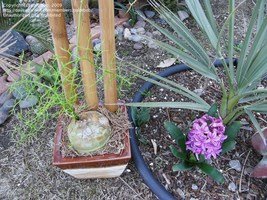
Hard to believe these two plants (Bowiea volubilis) and this Hyacynth are in the same family
The plant basically consists of a nearly spherical ball of succulent material that is very much like an onion, not just in shape, but in its semi-translucent concentric layers of fleshy, succulent material. I have never tasted one (mildly toxic, cardiac glycosides reportedly, though I have also heard of those eating it without incident) but it does not smell anything like an onion. Less than 10 percent of the sphere is buried in the soil where a mass of simple succulent roots grow straight down for three to six inches. Why this contact with the soil, particular wet soil, does not rot this onion-like plant is beyond me. It sure looks like something that would rot under my care. For much of the year (all year 'round here in southern California) there are vines of succulent, pale-green filamentous, flexible, somewhat rubbery, leafless growths from each bulb--sometimes two to three per bulb on particularly old or ‘happy' plants, or those about to divide. Plants do grow a leaf or two initially as the vine first starts to appear, but this are thin, temporary structures. During part of the year small pale green flowers appear on these vines but they are barely noticeable and certainly cause to grow this plant. Once the bulb has grown to its maximum size (about five inches in diameter in my garden... I read they can get as large as ten inches in diameter in very old plants, though) it starts to divide. The first signs of division are the production of multiple vines from the bulb. Then these growth centers seem to slowly spread apart leaving one with conjoined half-bulbs, each with a flat surface facing the other bulb. But it only takes several more months of growing and each bulb eventually rounds itself out into a nearly perfect sphere. Our largest plant grew from a just-divided pair to eight bulbs in about four years. I have no idea if these grow faster in the wild (southern Africa), or if this typical.
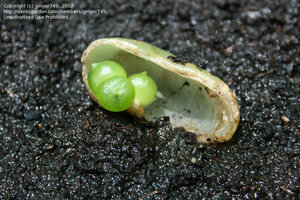
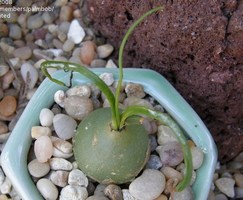
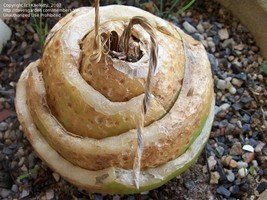
Baby Bowiea volubilis (photo ginger749); My own juvenile Bowiea showing a few leaves along with a vine starting; plant showing layers (photo Kaelkitty)
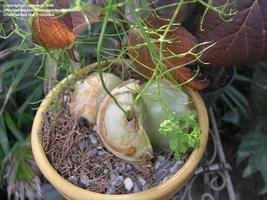
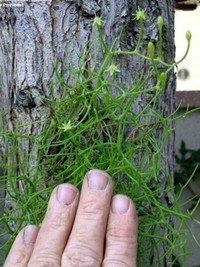
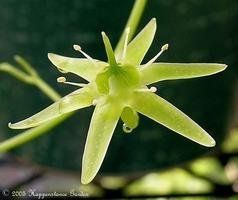
plant that has just divided showing flattened sides; flowers in spring on the vine; close up of a Bowiea flower (photo Happenstance)
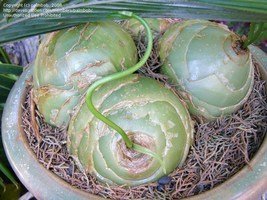
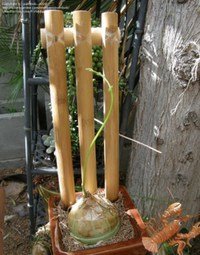
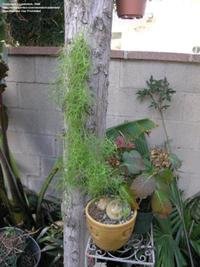
Several Bowieas with vines just starting to emerge typical 'head of hair' on potted plant
Growing this plant is amazingly easy (as close to what is called a ‘no-brainer' as I can get in my collection). The following are some general suggestions on how to cultivate Bowieas.
Soil: normal potting soil works well, though I tend to grow everything in either cactus soil or soil amended with a lot of pumice or perlite. I don't think that's necessary with this plant as it seems very unpicky about most things. Reportedly very acidic soils are harsh on it, so avoid soils made for ferns or Azaleas. I would also avoid pure clay even though it is a lot less likely to rot than it looks, I bet it could still be done. I have seen these buried halfway into the soil, but I barely submerge any of the bulb (looks better that way to me anyway).
Cold and Heat: I have little experience growing this species indoors so I cannot comment too much other than others have recommended growing this plant between 50F to 70F (10C to 24C) indoors. Some internet sites consider Bowiea volubilis to be a zone 11 plant (growing in USDA zone 11 or warmer). However, this is certainly not the case in California, where most can get them to survive outdoors in the right spot in zones 9b and up. I had a freeze in my yard where it was 25F (-4C) for over 7 straight hours, and many succulents were damaged or killed. However, the Bowieas were not among these victims, and seemed completely unharmed. I wouldn't recommend planting them in situations where it will freeze frequently, but it sure seems mild frosts cannot do them much harm. Outdoors in a warm arid climate this plant seems to tolerate a wide variety of temperature extremes. It has gotten as hot as 120F here (50C) and this plant has not looked too stressed. However it does seem somewhat happier and looks better in the cooler weather here in southern California. Extreme heat, particularly along with direct sun does dry up some of the vines. Note in the photo below on the right the dried vines and dried peeling skin- typical looks in summer heat.
Light: The bulb itself prefers some shade, at least in the hotter part of the day. Mine are growing in half day sun so by about an hour after noon they are in the shade. This has seemed to work out well, though blazing hot summer days does dry out the outer layer of the ‘onion' a bit browning it. I have seen sources that claim the bulb should be in full shade, and obviously it performs well as a house plant, so I think that might be OK. But I certainly don't think that is essential. The vines grow up into the sun more and do not seem to have any damage from hot afternoon sun.
Water: I water mine frequently in the spring, summer and fall, and the rain waters it all winter. I have yet to have a single plant rot from overwatering, or from constant days of cold, wet winter weather. I did learn from personal experience, however, that under-watering this plant will stress it severely. It may look drought tolerant, but not watering this orb, at least when it is warm, is going to cause it to shrivel and get soft to the touch. When I first experienced this I assumed that my worst fears were realized: I had rotted it by overwatering it, though I really had hardly been watering it at all. As it got softer and softer I got more desperate to save it, and finally figured I would try to water it well as not watering it was only making it worse. To my amazement, but supposedly rotting bulb immediately fattened up, becoming firm and looked normal in just a few days. Now I water it like I water the nearby palms.
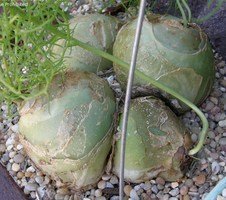
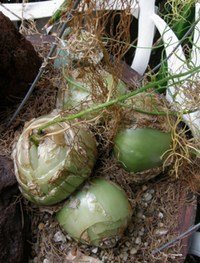
It might not be obvious from the photo, but these two globes in front are discolored, soft and shrunken in summer. I just watered these more finally and they immediately plumped up and looked great (see how much shinier the plants on the right are?)
Fertilizer: I read that this plant should only be lightly fertilized twice yearly, but my outdoor plants never get fertilized (a lot of leaf material, particularly Italian Cypress droppings, fall into my pots and that may be fertilizing my succulents as that stuff rots). They seem fine. If you do water it, I would recommend a half-strength cactus fertilizer, and avoid acidic combinations.
Dormancy: I was surprised to find conflicting reports on this plant's dormancy. Some say it goes dormant in winter and not to water it then. Other sources say this is a winter grower. I can tell you from personal experience that, in this southern California climate, dormancy is unclear. This plant is never really dormant outdoors here in Southern California, at least in my yard. Sometimes a vine will dry up in warmer weather, but it is nearly almost always replaced soon after by a new one coming in. If one correlates dormancy with vine production, I will agree with the winter growing proponents as these plants definitely are more vigorous about making large crops of wild green ‘hair' in winter than during the rest of the year, but I never see my plants without green vines growing out them, no matter what time of year it is.
Pot Culture: Bowiea are ideal pot plants as their roots don't take up much room and the plants seem to grow well, even if seeming crammed into a small pot (some consider this an attractive look). One could probably keep the same plant in a small pot for many years. However, for root health it is a good idea to change soil every 2-5 years. These plants tolerate being dug up and replanted with hardly any hint of stress. My challenge when I have these plants in a pot is what to do with the vines. There are many inventive and clever ways to provide structures for these plants to grow up so that the vines don't just end up all over the place, wrapping themselves around nearby plants and creating problems. It is easy to train the vines to grow around hangers, wooden trellises, tomato cages etc.
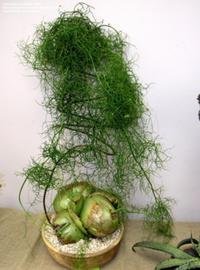 show plant with all the vines trained around a bent wire
show plant with all the vines trained around a bent wire
Landscaping: To grow Bowiea volubilis in the landscape, you need to be living in a fairly arid and warm climate (Bowieas do not seem to tolerate growing in humid tropical climates, nor in snow). However, they grow pretty well in most conditions, though some do not find them the most attractive of landscape plants. Left unattended in the garden, one may not even get to see the bulbs, only a mass of thin, twisted green vines.
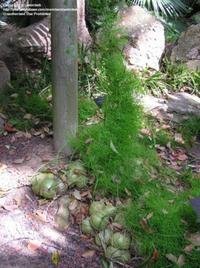
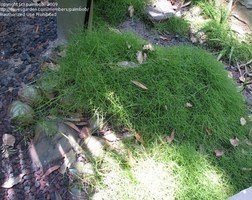
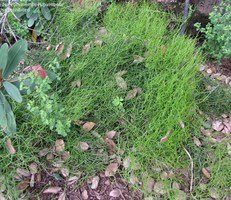
Bowiea volubilis in the landscaping- note that as the vines grow, the bulbs vanish from view
Other species? Bowiea garipensis is considered to be another species, though it was originally described as a subspecies of Bowiea volubilis. It is reportedly a slightly large species (I have not seen a large one, though) and it has even more rubber, more blunted vining ‘branches' and a pale brown peeling capsule. As my Bowiea gariepensis plants mature I will be able to add more comments about any other differences there may be.
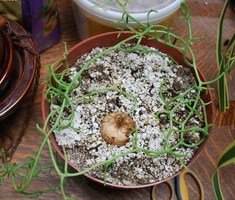 Mail order plant of Bowiea gariepensis.
Mail order plant of Bowiea gariepensis.
Obtaining a plant: These plants seem have a wide range of prices depending on where you look. I have seen them way over-priced, but have gotten most of mine very cheaply. I recommend getting these relatively small if you cannot find a cheap larger one. They grow so fast and reliably that small plants turn into large ones in no time, so it is not one of those succulent species one should invest a lot an older, large bulb. Of course a plant with a half-dozen bulbs or more is an older plant that will take 5 to 10 years to grow from a tiny sphere, so those plants might be worth a lot more. So if you find one that is affordable, get it. You will not regret it.
Copyright © www.100flowers.win Botanic Garden All Rights Reserved